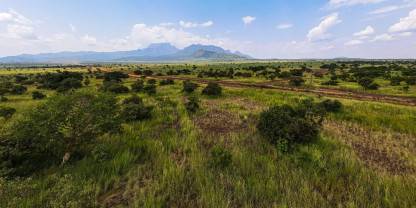Pian Upe Wildlife Reserve protects a vast tract of acacia savannah in a remote part of eastern Uganda to the north of Mt Elgon. It is Uganda’s second-largest protected area, but also its most remote and least visited safari destination. Wildlife is varied, but densities are low, and much of the reserve’s appeal lies in its wilderness feel.

-
Best Time To Go
- November to March (Dry season)
-
High Season
- June to September (But it’s never busy)
-
Size
- 2,788km² / 1,076mi²
-
Altitude
-
1,044-2,489m /3,425-8,166ft
 View Photos
View Photos
 View Photos
+2
Photos
View Photos
+2
Photos
Pros & Cons
- Uganda’s largest cheetah population
- A varied selection of antelope and other ungulates
- The dry-country birdlife includes many species absent from western Uganda
- Home to Fox’s weaver, Uganda’s only endemic bird species
- Easily incorporated into an eastern safari with Kidepo Valley National Park
- Cultural encounters with traditional Pian and Upe pastoralists
- Low tourist numbers give it an off-the-beaten-track charm
- Tourist amenities are limited and on the basic side
- Only two of the Big Five (leopard and buffalo) are present
Wildlife
A safari to Pian Upe is about the wilderness experience rather than chasing large herds of wildlife. But while mammal densities are low, there is a fair variety and numbers are on the increase. Regularly seen animals include buffalo, plains zebra, Rothschild’s giraffe, patas monkey, eland, greater kudu and Uganda’s only roan antelope. Cheetah, though not common, are a star attraction. For birders, a checklist of 250 species includes ostrich, Jackson’s hornbill, white-headed buffalo-weaver and the endemic Fox’s weaver.
Scenery
Pian Upe is dominated by open plains covered in thorny acacia savannah. A scenic highlight is Loporokocho Swamp, which also usually offers fair wildlife viewing and excellent bird watching. The plains of Pian Upe are surrounded by impressive volcanically formed mountains. These include the 4,321m/14,177ft Mt Elgon (Africa’s eighth-highest massif) to the south and 3,063m/10,049ft Mt Kadam to the east.
Activities
are the main activity, though be warned that more remote tracks might be overgrown. Guided walks are also possible by arrangement with the rangers. In both cases, mammal viewing can be slow going, but the birding is likely to be very rewarding (especially in the early morning). Guided hikes to the summit of Mt Kadam, just outside the park boundary, are also possible.
Weather & Climate
Pian Upe’s weather and climate is similar to that of Kidepo Valley National Park. More info:
Best Time To Visit
Pian Upe is at its best in the Dry season, which runs from November to March. The dry conditions mean that tracks are in relatively good shape and wildlife tends to gather around permanent water sources. Conditions in the Wet season (April to October) are less predictable, as some years are much more rainy than others. But there is a high risk of tracks becoming impassable and tall grass making it difficult to see wildlife.
How To Get to Pian Upe WR
Moruajore, the park headquarters for Pian Upe, lies about 310km/190mi northeast of the capital Kampala via the cities of Jinja and Mbale. Allow up to 8 hours* for the direct drive. Continuing north from Moruajore it is another 330km/205mi to Kidepo Valley National Park, which also takes about 8 hours* to drive.
*Driving times are only a rough indication. You should always consider the possibility of significant delays.
Health & Safety
Please read our malaria and vaccinations page for Uganda, and our general ‘Wildlife Viewing Safety Precautions’ below for more info:




